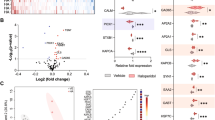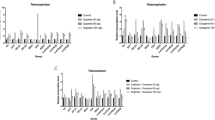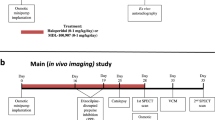Abstract
Recent neuroanatomical and functional investigations focusing on dopamine (DA) D3 receptors have suggested a potential role of this receptor in psychiatric diseases such as schizophrenia and drug dependence. In line with the key role of the prefrontal cortex in psychiatric disorders, the present study aimed at assessing the effects of the acute systemic administration of the selective DA D3 receptor antagonist SB-277011-A on the in vivo extracellular levels of monoamines (DA, norepinephrine (NE), and serotonin (5-HT)) and acetylcholine (ACh) in the anterior cingulate subregion of the medial prefrontal cortex. The in vivo neurochemical profile of SB-277011-A (10 mg/kg, i.p.) in the anterior cingulate cortex was compared with both typical and atypical antipsychotics including clozapine (10 mg/kg, s.c.), olanzapine (10 mg/kg, s.c.), sulpiride (10 mg/kg, s.c.), and haloperidol (0.5 mg/kg, s.c.). The acute administration of SB-277011-A, clozapine, and olanzapine produced a significant increase in extracellular levels of DA, NE, and ACh without affecting levels of 5-HT. Sulpiride also significantly increased extracellular DA, but with a delayed onset over SB-277011-A, clozapine, and olanzapine. In contrast, haloperidol failed to alter any of the three monoamines and ACh in the anterior cingulate cortex. These findings add to a growing body of evidence suggesting a differentiation between typical and atypical antipsychotic drugs (APDs) in the anterior cingulate cortex and a role of DA D3 receptors in desired antipsychotic drug profile. Similar to their effects on DA and NE, SB-277011-A, clozapine, and olanzapine increased extracellular levels of ACh, whereas haloperidol and sulpiride did not alter ACh. The results obtained in the present study provide evidence of the important role of DA D3 receptors in the effect of pharmacotherapeutic agents that are used for the treatment of psychiatric disorders such as schizophrenia and drug dependence.
Similar content being viewed by others
Log in or create a free account to read this content
Gain free access to this article, as well as selected content from this journal and more on nature.com
or
References
Acquas E, Di Chiara G (1999). Local application of SCH39166 reversibly and dose-dependently decreases acetylcholine release in the rat striatum. Eur J Pharmacol 383: 275–279.
Acquas E, Fibiger HC (1998). Dopaminergic regulation of striatal acetylcholine release: the critical role of acetylcholinesterase inhibition. J Neurochem 70: 1088–1093.
Acri JB, Carter SR, Alling K, Geter-Douglass B, Dijkstra D, Wikstrom H et al (1995). Assessment of cocaine-like discriminative stimulus effects of dopamine D3 receptor ligands. Eur J Pharmacol 281: R7–R9.
Aigner TG, Mitchell SJ, Aggleton JP, DeLong MR, Struble RG, Price DL et al (1987). Effects of scopolamine and physostigmine on recognition memory in monkeys with ibotenic-acid lesions of the nucleus basalis of Meynert. Psychopharmacology (Berl) 92: 292–300.
Arnt J, Skarsfeldt T (1998). Do novel antipsychotics have similar pharmacological characteristics? A review of the evidence. Neuropsychopharmacology 18: 63–101.
Ashby Jr CR, Minabe Y, Stemp G, Hagan JJ, Middlemiss DN (2000). Acute and chronic administration of the selective D(3) receptor antagonist SB-277011-A alters activity of midbrain dopamine neurons in rats: an in vivo electrophysiological study. J Pharmacol Exp Ther 294: 1166–1174.
Austin NE, Baldwin, Cutler L, Deeks N, Kelly PJ, Nash M et al (2001). Pharmacokinetics of the novel, high-affinity and selective dopamine D3 receptor antagonist SB-277011 in rat, dog and monkey: in vitro /in vivo correlation and the role of aldehyde oxidase. Xenobiotica 31: 677–686.
Broersen LM, Heinsbroek RP, de Bruin JP, Uylings HB, Olivier B (1995). The role of the medial prefrontal cortex of rats in short-term memory functioning: further support for involvement of cholinergic, rather than dopaminergic mechanisms. Brain Res 674: 221–229.
Bunney BS (1992). Clozapine: a hypothesised mechanism for its unique clinical profile. Br J Psychiatry 17(Suppl): 17–21.
Bymaster FP, Calligaro DO, Falcone JF, Marsh RD, Moore NA, Tye NC, Seeman P, Wong DT (1996). Radioreceptor binding profile of the atypical antipsychotic olanzapine. Neuropsychopharmacology 14: 87–96.
Caine SB, Koob GF (1993). Modulation of cocaine self-administration in the rat through D-3 dopamine receptors. Science 260: 1814–1816.
Caine SB, Koob GF, Parsons LH, Everitt BJ, Schwartz JC, Sokoloff P (1997). D3 receptor test in vitro predicts decreased cocaine self-administration in rats. Neuroreport 8: 2373–2377.
Carboni E, Tanda GL, Frau R, Di Chiara G (1990). Blockade of the noradrenaline carrier increases extracellular dopamine concentrations in the prefrontal cortex: evidence that dopamine is taken up in vivo by noradrenergic terminals. J Neurochem 55: 1067–70.
Carlsson A (1978). Antipsychotic drugs, neurotransmitters, and schizophrenia. Am J Psychiatry 135: 165–173.
Casey DE (1997). The relationship of pharmacology to side effects. J Clin Psychiatry 58: 55–62.
Davis KL, Kahn RS, Ko G, Davidson M (1991). Dopamine in schizophrenia: a review and reconceptualization. Am J Psychiatry 148: 1474–1486.
DeBoer P, Abercrombie ED (1996). Physiological release of striatal acetylcholine in vivo: modulation by D1 and D2 dopamine receptor subtypes. J Pharmacol Exp Ther 277: 775–783.
Di Chiara G, Tanda G, Carboni E (1996). Estimation of in vivo neurotransmitter release by brain microdialysis: the issue of validity. Behav Pharmacol 7: 640–657.
Di Ciano P, Underwood R, Hagan JJ, Everitt BJ (2001). Attenuation of cue-controlled drug-seeking by a selective D3 dopamine receptor antagonist. Behav Pharmacol 12: S29.
Gessa GL, Devoto P, Diana M, Flore G, Melis M, Pistis M (2000). Dissociation of haloperidol, clozapine, and olanzapine effects on electrical activity of mesocortical dopamine neurons and dopamine release in the prefrontal cortex. Neuropsychopharmacology 22: 642–649.
Giovannini MG, Bartolini L, Kopf SR, Pepeu G (1998). Acetylcholine release from the frontal cortex during exploratory activity. Brain Res 784: 218–227.
Goldman-Rakic PS, Selemon LD (1997). Functional and anatomical aspects of prefrontal pathology in schizophrenia. Schizophr Bull 23: 437–458.
Grenhoff J, Nisell M, Ferre S, Aston-Jones G, Svensson TH (1993). Noradrenergic modulation of midbrain dopamine cell firing elicited by stimulation of the locus coeruleus in the rat. J Neural Transm Gen Sect 93: 11–25.
Gresch PJ, Sved AF, Zigmond MJ, Finlay JM (1995). Local influence of endogenous norepinephrine on extracellular dopamine in rat medial prefrontal cortex. J Neurochem 65: 111–116.
Guo N, Klitenick MA, Tham CS, Fibiger HC (1995). Receptor mechanisms mediating clozapine-induced c-fos expression in the forebrain. Neuroscience 65: 747–756.
Guo N, Vincent SR, Fibiger HC (1998). Phenotypic characterization of neuroleptic-sensitive neurons in the forebarin: constrasting targets of haloperidol and clozapine. Neuropsychopharmacology 19: 133–145.
Gurevich EV, Bordelon Y, Shapiro RM, Arnold SE, Gur RE, Joyce JN (1997). Mesolimbic dopamine D3 receptors and use of antipsychotics in patients with schizophrenia. A postmortem study. Arch Gen Psychiatry 54: 225–232.
Gurevich EV, Joyce JN (1999). Distribution of dopamine D3 receptor expressing neurons in the human forebrain: comparison with D2 receptor expressing neurons. Neuropsychopharmacology 20: 60–80.
Heidbreder CA, Foxton R, Cilia J, Hughes ZA, Shah AJ, Atkins A et al (2001a). Increased responsiveness of dopamine to atypical, but not typical antipsychotics in the medial prefrontal cortex of rats reared in isolation. Psychopharmacology (Berl) 156: 338–351.
Heidbreder CA, Lacroix L, Atkins AR, Organ AJ, Murray S, West A et al (2001b). Development and application of a sensitive high performance ion-exchange chromatography method for the simultaneous measurement of dopamine, 5-hydroxytryptamine and norepinephrine in microdialysates from the rat brain. J Neurosci Methods 112: 135–144.
Herroelen L, De Backer JP, Wilczak N, Flamez A, Vauquelin G, De Keyser J (1994). Autoradiographic distribution of D3-type dopamine receptors in human brain using [3H]7-hydroxy-N,N-di-n-propyl-2-aminotetralin. Brain Res 648: 222–228.
Himmelheber AM, Fadel J, Sarter M, Bruno JP (1998). Effects of local cholinesterase inhibition on acetylcholine release assessed simultaneously in prefrontal and frontoparietal cortex. Neuroscience 86: 949–957.
Hironaka N, Tanaka K, Izaki Y, Hori K, Nomura M (2001). Memory-related acetylcholine efflux from rat prefrontal cortex and hippocampus: a microdialysis study. Brain Res 901: 143–150.
Hows MEP, Organ AJ, Murray S, Dawson L, Heidbreder C, Hughes ZA et al (2002). High-performance liquid chromatography/tandem mass spectrometry assay for the rapid high sensitivity measurement of basal acetylcholine in microdialysates. J Neurosci Methods 121: 33–39.
Ichikawa J, Dai J, Meltzer HY (2000). Acetylcholinesterase inhibitors are neither necessary nor desirable for microdialysis studies of brain acetylcholine. Curr Separ 19: 37–44.
Ichikawa J, Dai J, O'Laughlin IA, Fowler WL, Meltzer HY (2002). Atypical, but not typical, antipsychotic drugs increase cortical acetylcholine release without an effect in the nucleus accumbens or striatum. Neuropsychopharmacology 26: 325–339.
Ichikawa J, Meltzer HY (1999). R(+)-8OH-DPAT, a serotonin(1A) receptor agonist, potentiated S(−)-sulpiride-induced dopamine release in rat medial prefrontal cortex and nucleus accumbens but not striatum. J Pharmacol Exp Ther 291: 1227–1232.
Izurieta-Sanchez P, Jonkers N, Sarre S, Ebinger G, Michotte Y (2000). Neostigmine influences the L-dopa-induced extracellular dopamine levels in the striatum. Brain Res 856: 250–253.
Kawahara H, Kawahara Y, Westerink BH (2001). The noradrenaline-dopamine interaction in the rat medial prefrontal cortex studied by multi-probe microdialysis. Eur J Pharmacol 418: 177–186.
Khroyan TV, Fuchs RA, Baker DA, Neisewander JL (1997). Effects of D3-preferring agonists 7-OH-PIPAT and PD-128,907 on motor behaviors and place conditioning. Behav Pharmacol 8: 65–74.
Kinon BJ, Lieberman JA (1996). Mechanisms of action of atypical antipsychotic drugs: a critical analysis. Psychopharmacology 124: 2–34.
Kovacs KJ, Csejtei M, Laszlovszky I (2001). Double activity imaging reveals distinct cellular targets of haloperidol, clozapine and dopamine D(3) receptor selective RGH-1756. Neuropharmacology 40: 383–393.
Kuroki T, Meltzer HY, Ichikawa J (1999). Effects of antipsychotic drugs on extracellular dopamine levels in rat medial prefrontal cortex and nucleus accumbens. J Pharmacol Exp Ther 288: 774–781.
Landwehrmeyer B, Mengod G, Palacios JM (1993). Dopamine D3 receptor mRNA and binding sites in human brain. Brain Res Mol Brain Res 18: 187–192.
Le Foll B, Frances H, Diaz J, Schwartz J-C, Sokoloff P (2002). Role of the dopamine D3 receptor in reactivity to cocaine-associated cues in mice. Eur J Neurosci 15: 2016–2026.
Lee MA, Thompson PA, Meltzer HY (1994). Effects of clozapine on cognitive function in schizophrenia. J Clin Psychiatry 55: 82–87.
Lewander T (1994). Overcoming the neuroleptic-induced deficit syndrome: clinical observations with remoxipride. Acta Psychiatr Scand 380(Suppl): 64–67.
Li XM, Perry KW, Wong DT, Bymaster FP (1998). Olanzapine increases in vivo dopamine and norepinephrine release in rat prefrontal cortex, nucleus accumbens and striatum. Psychopharmacology 136: 153–161.
Manschreck TC, Redmond DA, Candela SF, Maher BA (1999). Effects of clozapine on psychiatric symptoms, cognition, and functional outcome in schizophrenia. J Neuropsychiatry Clin Neurosci 11: 481–489.
Meltzer HY (1996). Pre-clinical pharmacology of atypical antipsychotic drugs: a selective review. Br J Psychiatry 29(Suppl): 23–31.
Meltzer HY, Stahl SM (1976). The dopamine hypothesis of schizophrenia: a review. Schizophr Bull 2: 19–76.
Messer WS, Stibbe JR, Bohnett M (1991). Involvement of the septohippocampal cholinergic system in representational memory. Brain Res 564: 66–72.
Miller JC (1990). Induction of c-fos mRNA expression in rat striatum by neuroleptic drugs. J Neurochem 54: 1453–145.
Moghaddam B, Bunney BS (1990). Acute effects of typical and atypical antipsychotic drugs on the release of dopamine from prefrontal cortex, nucleus accumbens, and striatum of the rat: an in vivo microdialysis study. J Neurochem 54: 1755–1760.
Mouton PR, Meyer EM, Dunn AJ, Millard W, Arendash GW (1988). Induction of cortical cholinergic hypofunction and memory retention deficits through intracortical AF64A infusions. Brain Res 444: 104–118.
Murray AM, Ryoo HL, Gurevich E, Joyce JN (1994). Localization of dopamine D3 receptors to mesolimbic and D2 receptors to mesostriatal regions of human forebrain. Proc Natl Acad Sci USA 91: 11271–11275.
Neve KA, Neve RL (1997). The dopamine receptors. In Neve KA, Neve RL (eds). Molecular Biology of Dopamine Receptors. Humana Press: Totowa, NJ. pp 27–76.
Nguyen TV, Kosofsky BE, Birnbaum R, Cohen BM, Hyman SE (1992). Differential expression of c-fos and zif268 in rat striatum after haloperidol, clozapine, and amphetamine. Proc Natl Acad Sci 89: 4270–4274.
Nomikos GG, Iurlo M, Andersson JL, Kimura K, Svensson TH (1994). Systemic administration of amperozide, a new atypical antipsychotic drug, preferentially increases dopamine release in the rat medial prefrontal cortex. Psychopharmacology 115: 147–156.
Paxinos G, Watson C (1986). The rat brain in stereotaxic coordinates. Academic Press: San Diego.
Parada MA, Hernandez L, Puig de Parada M, Rada P, Murzi E (1997). Selective action of acute systemic clozapine on acetylcholine release in the rat prefrontal cortex by reference to the nucleus accumbens and striatum. J Pharmacol Exp Ther 281: 582–588.
Pehek EA, Yamamoto BK (1994). Differential effects of locally administered clozapine and haloperidol on dopamine efflux in the rat prefrontal cortex and caudate-putamen. J Neurochem 63: 2118–2124.
Peuskens J, Bech P, Moller HJ, Fleurot O, Rein W (1999). Amisulpride vs risperidone in the treatment of acute exacerbations of schizophrenia. Amisulpride study group. Psychiatry Res 88: 107–117.
Pilla M, Perachon S, Sautel F, Garrido F, Mann A, Wermuth CG et al (1999). Selective inhibition of cocaine-seeking behaviour by a partial dopamine D3 receptor agonist. Nature 400: 371–375.
Raedler TJ, Knable MB, Jones DW, Lafargue T, Urbina RA, Egan MF et al (2000). In vivo olanzapine occupancy of muscarinic acetylcholine receptors in patients with schizophrenia. Neuropsychopharmacology 23: 56–68.
Reavill C, Taylor SG, Wood MD, Ashmeade T, Austin NE, Avenell KY et al (2000). Pharmacological actions of a novel, high-affinity, and selective human dopamine D(3) receptor antagonist, SB-277011-A. J Pharmacol Exp Ther 294: 1154–1165.
Robertson GS, Fibiger HC (1992). Neuroleptics increase c-fos expression in the forebrain: contrasting effects of haloperidol and clozapine. Neuroscience 46: 315–328.
Scali C, Casamenti F, Pazzagli M, Bartolini L, Pepeu G (1994). Nerve growth factor increases extracellular acetylcholine levels in the parietal cortex and hippocampus of aged rats and restores object recognition. Neurosci Lett 170: 117–120.
Seeman P, Lee T, Chau-Wong M, Wong KP (1976). Antipsychotic drug doses and neuroleptic/dopamine receptors. Nature 261: 717–719.
Sethy VH, Ellerbrock BR, Wu H (1996). Comparative dopaminergic and muscarinic antagonist activity of clozapine and haloperidol. Life Sci 58: 585–590.
Sigala S, Missale C, Spano P (1997). Opposite effects of dopamine D2 and D3 receptors on learning and memory in the rat. Eur J Pharmacol 336: 107–112.
Sokoloff P, Giros B, Martres MP, Bouthenet ML, Schwartz JC (1990). Molecular cloning and characterization of a novel dopamine receptor (D3) as a target for neuroleptics. Nature 347: 146–151.
Sokoloff P, Schwartz JC (1995). Novel dopamine receptors half a decade later. Trends Pharmacol Sci 16: 270–275.
Staley JK, Mash DC (1996). Adaptive increase in D3 dopamine receptors in the brain reward circuits of human cocaine fatalities. J Neurosci 16: 6100–6106.
Suzuki M, Hurd YL, Sokoloff P, Schwartz JC, Sedvall G (1998). D3 dopamine receptor mRNA is widely expressed in the human brain. Brain Res 779: 58–74.
Tanda G, Pontieri FE, Frau R, Di Chiara G (1997). Contribution of blockade of the noradrenaline carrier to the increase of extracellular dopamine in the rat prefrontal cortex by amphetamine and cocaine. Eur J Neurosci 9: 2077–2085.
Tassin JP (1992). NE/DA interactions in prefrontal cortex and their possible roles as neuromodulators in schizophrenia. J Neural Transm 36(Suppl): 135–162.
Ukai M, Tanaka T, Kameyama T (1997). Effects of the dopamine D3 receptor agonist, R(+)-7-hydroxy-N,N-di-n-propyl-2-aminotetralin, on memory processes in mice. Eur J Pharmacol 324: 147–151.
Volonte M, Monferini E, Cerutti M, Fodritto F, Borsini F (1997). BIMG 80, a novel potential antipsychotic drug: evidence for multireceptor actions and preferential release of dopamine in prefrontal cortex. J Neurochem 69: 182–190.
Vorel SR, Ashby Jr CR, Paul M, Liu X, Hayes R, Hagan JJ, Middlerniss DN, Stemp G, Gardner EL (2002). Domapine D3 receptor antagonism inhibits cocaine-seeking and cocaine-enhanced brain reward in rats. J Neurosci 22: 9595–9603.
Weinberger DR, Lipska BK (1995). Cortical maldevelopment, anti-psychotic drugs, and schizophrenia: a search for common ground. Schizophr Res 16: 87–110.
Westerink BH, Kawahara Y, De Boer P, Geels C, De Vries JB, Wikstrom HV et al (2001). Antipsychotic drugs classified by their effects on the release of dopamine and noradrenaline in the prefrontal cortex and striatum. Eur J Pharmacol 412: 127–138.
Yamamoto BK, Novotney S (1998). Regulation of extracellular dopamine by the norepinephrine transporter. J Neurochem 71: 274–280.
Yamamoto M, Takahashi K, Ohyama M, Sasamata M, Yatsugi S, Okada M et al (1994). Possible involvement of central cholinergic system in ameliorating effects of indeloxazine, a cerebral activator, on disturbance of learning behavior in rats. Prog Neuropsychopharmacol Biol Psychiatry 18: 603–613.
Acknowledgements
The authors gratefully acknowledge the Laboratory Animal Science department for their support and excellent care of the animals used in the present study.
Author information
Authors and Affiliations
Corresponding author
Rights and permissions
About this article
Cite this article
Lacroix, L., Hows, M., Shah, A. et al. Selective Antagonism at Dopamine D3 Receptors Enhances Monoaminergic and Cholinergic Neurotransmission in the Rat Anterior Cingulate Cortex. Neuropsychopharmacol 28, 839–849 (2003). https://doi.org/10.1038/sj.npp.1300114
Received:
Revised:
Accepted:
Published:
Issue date:
DOI: https://doi.org/10.1038/sj.npp.1300114
Keywords
This article is cited by
-
Dopamine differently modulates central cholinergic circuits in patients with Alzheimer disease and CADASIL
Journal of Neural Transmission (2014)
-
Occupancy of Brain Dopamine D3 Receptors and Drug Craving: A Translational Approach
Neuropsychopharmacology (2013)
-
Dopamine D3 receptor antagonism—still a therapeutic option for the treatment of schizophrenia
Naunyn-Schmiedeberg's Archives of Pharmacology (2013)
-
Noradrenergic versus dopaminergic modulation of impulsivity, attention and monitoring behaviour in rats performing the stop-signal task
Psychopharmacology (2013)
-
Rationale in support of the use of selective dopamine D3 receptor antagonists for the pharmacotherapeutic management of substance use disorders
Naunyn-Schmiedeberg's Archives of Pharmacology (2013)



